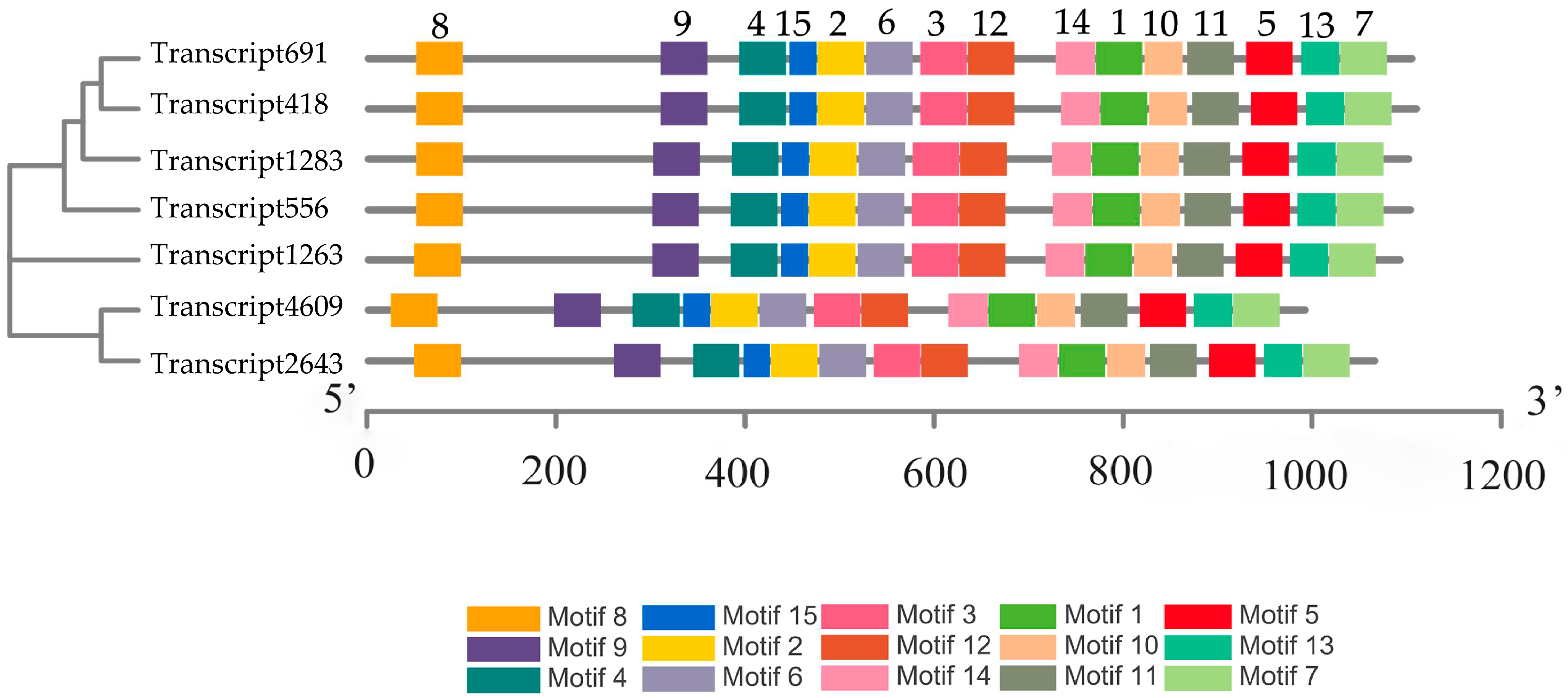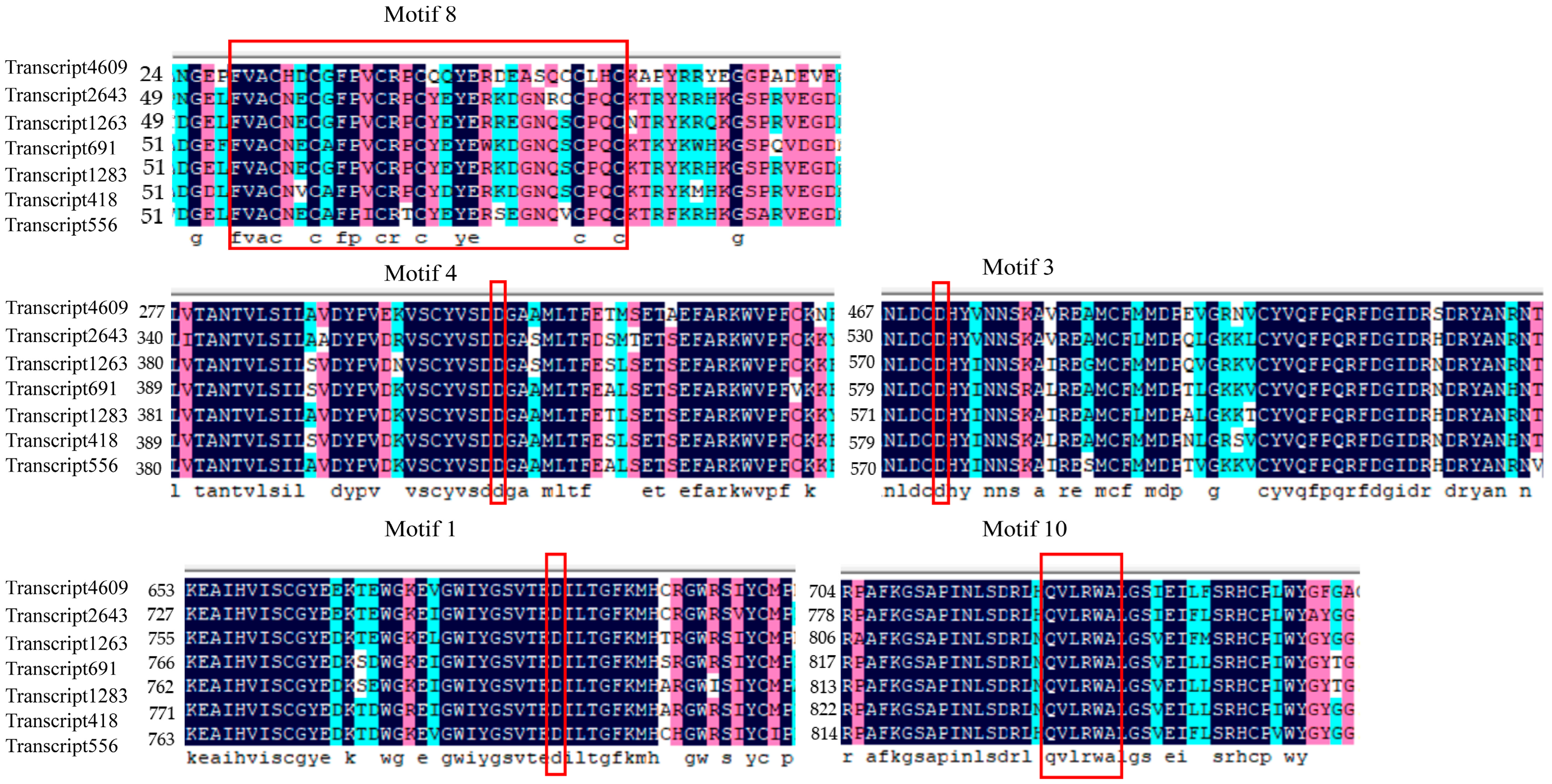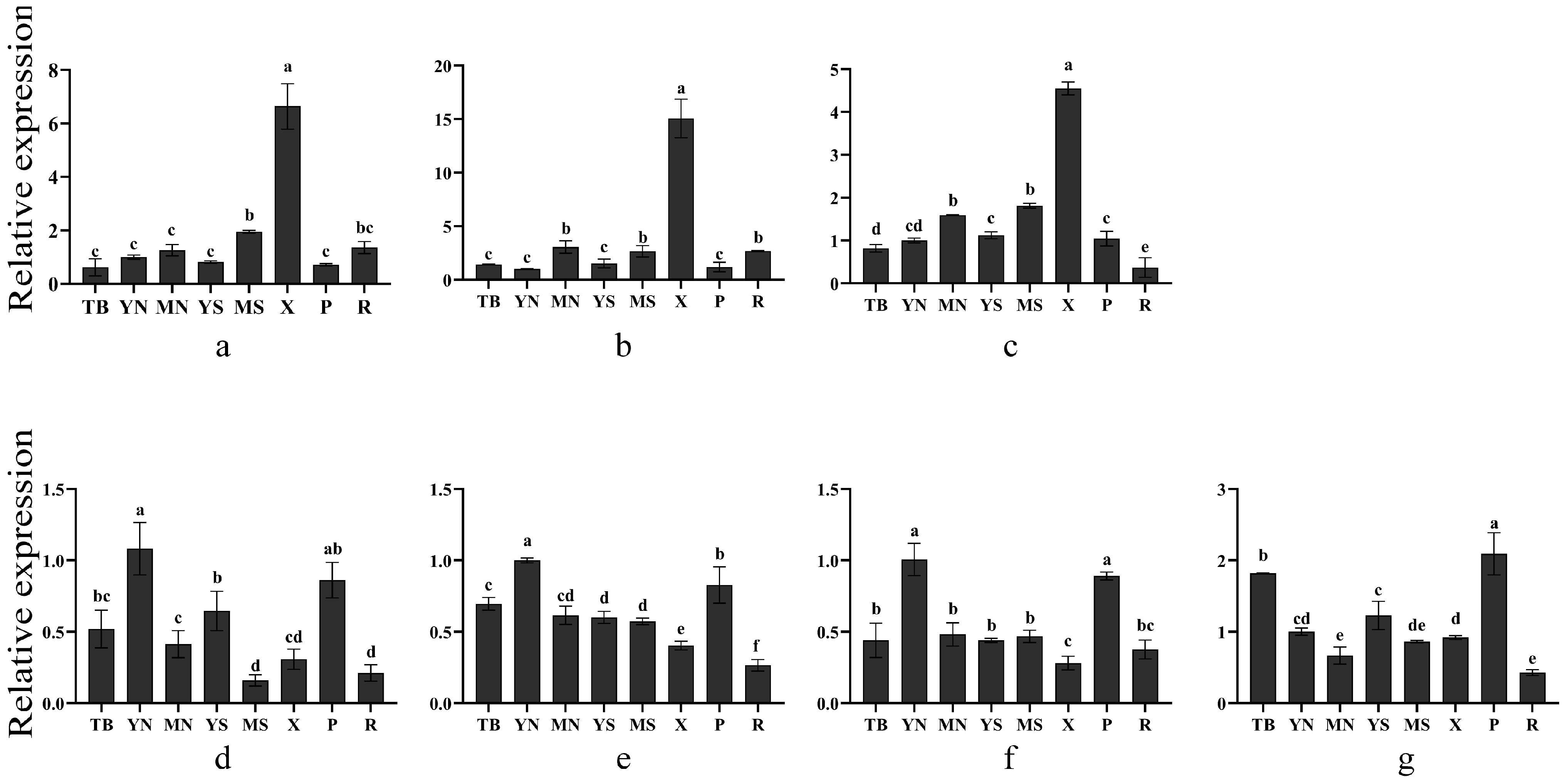Identification, Classification and Expression Analysis of the CesA Gene Family from Pinus massoniana
Abstract
1. Introduction
2. Materials and Methods
2.1. Plant Materials
2.2. Identification of CesA Genes in P. massoniana
2.3. Total RNA Extraction and Cloning ORF Sequences of -CesA Genes in P. massoniana
2.4. Sequence and Phylogenetic Analyses
2.5. Subcellular Localization
2.6. Real-Time Quantitative PCR
3. Results
3.1. Identification of CesA Genes and Cloning of Their ORF Sequences in P. massoniana
3.2. Structure Analysis of CESA Proteins in P. massoniana
3.3. Sequence and Phylogenetic Analyses of CesA Proteins in P. massoniana
3.4. Subcellular Localization of CesA Protein
3.5. Expression Levels of CesA Genes in Different Tissues or Organs
3.6. Expression Levels of CesA Genes under Different Treatments
4. Discussion
5. Conclusions
Supplementary Materials
Author Contributions
Funding
Data Availability Statement
Conflicts of Interest
References
- Que, F.; Zha, R.; Wei, Q. Advance research of cellulose synthase genes in plants. J. Nanjing For. Univ. (Nat. Sci. Ed.) 2022, 46, 207–214. [Google Scholar]
- Tian, A.; Xu, L.; Tao, G.; Yu, H.; Su, L.; Cao, J. Cellulose synthase in higher plants. Chin. J. Cell Biol. 2017, 39, 356–363. [Google Scholar]
- Lerouxel, O.; Cavalier, D.M.; Liepman, A.H.; Keegstra, K. Biosynthesis of plant cell wall polysaccharides—A complex process. Curr. Opin. Plant Biol. 2006, 9, 621–630. [Google Scholar] [CrossRef]
- Richmond, T.A.; Somerville, C.R. The cellulose synthase superfamily. Plant Physiol. 2000, 124, 495–498. [Google Scholar] [CrossRef] [PubMed]
- Pear, J.R.; Kawagoe, Y.; Schreckengost, W.E.; Delmer, D.P.; Stalker, D.M. Higher plants contain homologs of the bacterial celA genes encoding the catalytic subunit of cellulose synthase. Proc. Natl. Acad. Sci. USA 1996, 93, 12637–12642. [Google Scholar] [CrossRef]
- Arioli, T.; Peng, L.; Betzner, A.S.; Burn, J.; Wittke, W.; Herth, W.; Camilleri, C.; Hofte, H.; Plazinski, J.; Birch, R.; et al. Molecular analysis of cellulose biosynthesis in Arabidopsis. Science 1998, 279, 717–720. [Google Scholar] [CrossRef] [PubMed]
- Yin, Y.; Huang, J.; Xu, Y. The cellulose synthase superfamily in fully sequenced plants and algae. BMC Plant Biol. 2009, 9, 99. [Google Scholar] [CrossRef] [PubMed]
- Appenzeller, L.; Doblin, M.; Barreiro, R.; Wang, H.Y.; Niu, X.M.; Kollipara, K.; Carrigan, L.; Tomes, D.; Chapman, M.; Dhugga, K.S. Cellulose synthesis in maize: Isolation and expression analysis of the cellulose synthase (CesA) gene family. Cellulose 2004, 11, 287–299. [Google Scholar] [CrossRef]
- Suzuki, S.; Li, L.; Sun, Y.-H.; Chiang, V.L. The cellulose synthase gene superfamily and biochemical functions of xylem-specific cellulose synthase-like genes in Populus trichocarpa. Plant Physiol. 2006, 142, 1233–1245. [Google Scholar] [CrossRef]
- Purushotham, P.; Ho, R.; Zimmer, J. Architecture of a catalytically active homotrimeric plant cellulose synthase complex. Science 2020, 369, 1089–1094. [Google Scholar] [CrossRef]
- Park, S.; Ding, S.-Y. The N-terminal zinc finger of CELLULOSE SYNTHASE6 is critical in defining its functional properties by determining the level of homodimerization in Arabidopsis. Plant J. 2020, 103, 1826–1838. [Google Scholar] [CrossRef] [PubMed]
- Daras, G.; Templalexis, D.; Avgeri, F.; Tsitsekian, D.; Karamanou, K.; Rigas, S. Updating insights into the catalytic domain properties of plant cellulose synthase (CesA) and cellulose synthase-like (Csl) proteins. Molecules 2021, 26, 4335. [Google Scholar] [CrossRef]
- Richmond, T. Higher plant cellulose synthases. Genome Biol. 2000, 1, reviews3001. [Google Scholar] [PubMed]
- McFarlane, H.E.; Doering, A.; Persson, S. The cell biology of cellulose synthesis. In Annual Review of Plant Biology; Merchant, S.S., Ed.; Annual Reviews: San Mateo, CA, USA, 2014; Volume 65, pp. 69–94. [Google Scholar]
- Li, S.; Lei, L.; Gu, Y. Functional analysis of complexes with mixed primary and secondary cellulose synthases. Plant Signal. Behav. 2013, 8, e23179. [Google Scholar] [CrossRef]
- Persson, S.; Paredez, A.; Carroll, A.; Palsdottir, H.; Doblin, M.; Poindexter, P.; Khitrov, N.; Auer, M.; Somerville, C.R. Genetic evidence for three unique components in primary cell-wall cellulose synthase complexes in Arabidopsis. Proc. Natl. Acad. Sci. USA 2007, 104, 15566–15571. [Google Scholar] [CrossRef]
- Speicher, T.L.; Li, P.Z.; Wallace, I.S. Phosphoregulation of the plant cellulose synthase complex and cellulose synthase-like proteins. Plants 2018, 7, 52. [Google Scholar] [CrossRef]
- Zhang, S.-S.; Sun, L.; Dong, X.; Lu, S.-J.; Tian, W.; Liu, J.-X. Cellulose synthesis genes CESA6 and CSI1 are important for salt stress tolerance in Arabidopsis. J. Integr. Plant Biol. 2016, 58, 623–626. [Google Scholar] [CrossRef]
- Chen, Z.Z.; Hong, X.H.; Zhang, H.R.; Wang, Y.Q.; Li, X.; Zhu, J.K.; Gong, Z.Z. Disruption of the cellulose synthase gene, AtCesA8/IRX1, enhances drought and osmotic stress tolerance in Arabidopsis. Plant J. 2005, 43, 273–283. [Google Scholar] [CrossRef] [PubMed]
- Zhu, P.; Chen, Y.; Zhang, J.; Wu, F.; Wang, X.; Pan, T.; Wei, Q.; Hao, Y.; Chen, X.; Jiang, C.; et al. Identification, classification, and characterization of AP2/ERF superfamily genes in Masson pine (Pinus massoniana Lamb.). Sci. Rep. 2021, 11, 1–11. [Google Scholar] [CrossRef]
- Liu, X.; Yang, Z.; Chen, S.; Hu, L.; Wang, L.; Chen, G.; Yufen, L. Research status of Pinus massoniana modification. Guangxi For. Sci. 2022, 51, 285–289. [Google Scholar]
- Tan, J.; Tang, S.; Chen, H. Advances of drought resistance in Pinus massoniana. Guangxi For. Sci. 2017, 46, 1–7. [Google Scholar]
- Kang, C.; Zhao, X.; Wang, P.; Li, Y.; Tian, Z.; Wu, Z. Identification of the CesA gene family and analysis of response to abiotic stress in Cucumis sativus L. China Veg. 2022, 1, 29–41. [Google Scholar]
- Li, R.; Chen, P.; Zhu, L.; Wu, F.; Chen, Y.; Zhu, P.; Ji, K. Characterization and function of the 1-Deoxy-D-xylose-5-Phosphate Synthase (DXS) gene related to terpenoid synthesis in Pinus massoniana. Int. J. Mol. Sci. 2021, 22, 848. [Google Scholar] [CrossRef]
- Wu, F.; Sun, X.; Zou, B.; Zhu, P.; Lin, N.; Lin, J.; Ji, K. Transcriptional analysis of Masson pine (Pinus massoniana) under high CO2 stress. Genes 2019, 10, 804. [Google Scholar] [CrossRef] [PubMed]
- Huang, J.; Zhang, H. Development of nucleotide sequence analysis software based on Windows. Chin. J. Bioinform. 2004, 2, 13–17. [Google Scholar]
- Wang, L.; Guo, K.; Li, Y.; Tu, Y.; Hu, H.; Wang, B.; Cui, X.; Peng, L. Expression profiling and integrative analysis of the CESA/CSL superfamily in rice. BMC Plant Biol. 2010, 10, 282. [Google Scholar] [CrossRef]
- Li, Q.; Zhao, Q.; Yao, X.; Zhang, B.; Lu, L. Genome-wide characterization of the cellulose synthase gene superfamily in tea plants (Camellia sinensis). Phyton-Int. J. Exp. Bot. 2022, 91, 2163–2189. [Google Scholar] [CrossRef]
- Xu, S.; Zeng, B.; Fan, C.; Liu, Y.; Li, X.; Qiu, Z. Bioinformatics analyses of the Ces gene family in Eucalyptus grandis. Guangdong For. Sci. Technol. 2014, 30, 15–22. [Google Scholar]
- Huang, H.; Jiang, C.; Tong, Z.; Cheng, L.; Zhu, M.; Lin, E. Eight distinct cellulose synthase catalytic subunit genes from Betula luminifera are associated with primary and secondary cell wall biosynthesis. Cellulose 2014, 21, 2183–2198. [Google Scholar] [CrossRef]
- Wang, K.; Wang, Z.; Li, F.; Ye, W.; Wang, J.; Song, G.; Yue, Z.; Cong, L.; Shang, H.; Zhu, S.; et al. The draft genome of a diploid cotton Gossypium raimondii. Nat. Genet. 2012, 44, 1098–1103. [Google Scholar] [CrossRef] [PubMed]
- Liu, X.; Zhang, H.; Zhang, W.; Xu, W.; Li, S.; Chen, X.; Chen, H. Genome-wide bioinformatics analysis of cellulose synthase gene family in common bean (Phaseolus vulgaris L.) and the expression in the pod development. BMC Genom. Data 2022, 23, 9. [Google Scholar] [CrossRef] [PubMed]
- Kumar, S.; Stecher, G.; Li, M.; Knyaz, C.; Tamura, K. MEGA X: Molecular evolutionary genetics analysis across computing platforms. Mol. Biol. Evol. 2018, 35, 1547–1549. [Google Scholar] [CrossRef]
- Zhu, P.; Ma, Y.; Zhu, L.; Chen, Y.; Li, R.; Ji, K. Selection of suitable reference genes in Pinus massoniana Lamb. under different abiotic stresses for qPCR normalization. Forests 2019, 10, 632. [Google Scholar] [CrossRef]
- Zhai, Z.; Chen, X.N.; Wang, J. Primer disign with Primer Premier 5.0. Med. Educ. Res. Pract. 2008, 16, 695–698. [Google Scholar]
- Nguyen, D.T.; Guo, T.; Su, J.; Ji, K. Cloning on gene PmCesA2 encoding Pinus massoniana cellulose synthase and its plant expression vector construction. J. For. Eng. 2015, 29, 11–16. [Google Scholar]
- Nguyen, D.T.; Pan, T.; Ji, K. Cloning and analysis on PmCesA1 gene encoding Pinus massoniana cellulose synthase. Mol. Plant Breed. 2015, 13, 861–870. [Google Scholar]
- Maleki, S.S.; Mohammadi, K.; Movahedi, A.; Wu, F.; Ji, K.S. Increase in cell wall thickening and biomass production by overexpression of PmCesA2 in poplar. Front. Plant Sci. 2020, 11, 110. [Google Scholar] [CrossRef] [PubMed]
- Somerville, C. Cellulose synthesis in higher plants. Annu. Rev. Cell Dev. Biol. 2006, 22, 53–78. [Google Scholar] [CrossRef]
- Endler, A.; Persson, S. Cellulose synthases and synthesis in Arabidopsis. Mol. Plant 2011, 4, 199–211. [Google Scholar] [CrossRef]
- Paredez, A.R.; Somerville, C.R.; Ehrhardt, D.W. Visualization of cellulose synthase demonstrates functional association with microtubules. Science 2006, 312, 1491–1495. [Google Scholar] [CrossRef]
- Verma, V.; Ravindran, P.; Kumar, P.P. Plant hormone-mediated regulation of stress responses. BMC Plant Biol. 2016, 16, 86. [Google Scholar] [CrossRef]
- Xu, Z.-C.; Kong, Y. Genome-wide identification, subcellular localization and gene expression analysis of the members of CESA gene family in common tobacco (Nicotiana tabacum L.). Hereditas 2017, 39, 512–524. [Google Scholar]
- Delmer, D.P. Cellulose biosynthesis: Exciting times for a difficult field of study. Annu. Rev. Plant Physiol. Plant Mol. Biol. 1999, 50, 245–276. [Google Scholar] [CrossRef]
- Pancaldi, F.; van Loo, E.N.; Schranz, M.E.; Trindade, L.M. Genomic architecture and evolution of the cellulose synthase gene superfamily as revealed by phylogenomic analysis. Front. Plant Sci. 2022, 13, 870818. [Google Scholar] [CrossRef]
- Cosgrove, D.J. Growth of the plant cell wall. Nat. Rev. Mol. Cell Biol. 2005, 6, 850–861. [Google Scholar] [CrossRef] [PubMed]
- Taylor, N.G.; Howells, R.M.; Huttly, A.K.; Vickers, K.; Turner, S.R. Interactions among three distinct CesA proteins essential for cellulose synthesis. Proc. Natl. Acad. Sci. USA 2003, 100, 1450–1455. [Google Scholar] [CrossRef] [PubMed]
- Abbas, M.; Peszlen, I.; Shi, R.; Kim, H.; Katahira, R.; Kafle, K.; Xiang, Z.; Huang, X.; Min, D.; Mohamadamin, M.; et al. Involvement of CesA4, CesA7-A/B and CesA8-A/B in secondary wall formation in Populus trichocarpa wood. Tree Physiol. 2020, 40, 73–89. [Google Scholar] [CrossRef] [PubMed]
- Xu, W.; Cheng, H.; Zhu, S.; Cheng, J.; Ji, H.; Zhang, B.; Cao, S.; Wang, C.; Tong, G.; Zhen, C.; et al. Functional understanding of secondary cell wall cellulose synthases in Populus trichocarpa via the Cas9/gRNA-induced gene knockouts. New Phytol. 2021, 231, 1478–1495. [Google Scholar] [CrossRef] [PubMed]
- Tanaka, K.; Murata, K.; Yamazaki, M.; Onosato, K.; Miyao, A.; Hirochika, H. Three distinct rice cellulose synthase catalytic subunit genes required for cellulose synthesis in the secondary wall. Plant Physiol. 2003, 133, 73–83. [Google Scholar] [CrossRef] [PubMed]
- Djerbi, S.; Lindskog, M.; Arvestad, L.; Sterky, F.; Teeri, T.T. The genome sequence of black cottonwood (Populus trichocarpa) reveals 18 conserved cellulose synthase (CesA) genes. Planta 2005, 221, 739–746. [Google Scholar] [CrossRef]
- Mutwil, M.; Debolt, S.; Persson, S. Cellulose synthesis: A complex complex. Curr. Opin. Plant Biol. 2008, 11, 252–257. [Google Scholar] [CrossRef] [PubMed]
- Ling, L.; Xiaolong, W.; Qiang, Z. Research progress of abiotic stress responsive signal pathway in plant. Mol. Plant Breed. 2018, 16, 614–625. [Google Scholar]
- Zhao, S.; Zhang, Q.; Liu, M.; Zhou, H.; Ma, C.; Wang, P. Regulation of plant responses to salt stress. Int. J. Mol. Sci. 2021, 22, 4609. [Google Scholar] [CrossRef]
- Ellis, C.; Karafyllidis, I.; Wasternack, C.; Turner, J.G. The Arabidopsis mutant cev1 links cell wall signaling to jasmonate and ethylene responses. Plant Cell 2002, 14, 1981. [Google Scholar] [CrossRef] [PubMed]
- Zhu, J.; Lee, B.-H.; Dellinger, M.; Cui, X.; Zhang, C.; Wu, S.; Nothnagel, E.A.; Zhu, J.-K. A cellulose synthase-like protein is required for osmotic stress tolerance in Arabidopsis. Plant J. 2010, 63, 128–140. [Google Scholar] [CrossRef]






| Gene ID | ORF (bp) | Amino Acid No. | Molecular Mass (Da) | Isoelectric Points | Predicted TMHs 1 No. | Subcellular Localization |
|---|---|---|---|---|---|---|
| Transcript4609 | 2955 | 984 | 110807.39 | 5.96 | 6 | Plasma membrane |
| Transcript2643 | 3174 | 1057 | 119729.90 | 8.27 | 8 | Plasma membrane |
| Transcript1263 | 3255 | 1084 | 122204.09 | 6.70 | 8 | Plasma membrane |
| Transcript691 | 3291 | 1096 | 123411.08 | 6.42 | 8 | Plasma membrane |
| Transcript1283 | 3282 | 1093 | 123212.84 | 6.21 | 6 | Plasma membrane |
| Transcript418 | 3306 | 1101 | 123447.25 | 6.60 | 8 | Plasma membrane |
| Transcript556 | 3288 | 1095 | 123780.26 | 6.57 | 8 | Plasma membrane |
Disclaimer/Publisher’s Note: The statements, opinions and data contained in all publications are solely those of the individual author(s) and contributor(s) and not of MDPI and/or the editor(s). MDPI and/or the editor(s) disclaim responsibility for any injury to people or property resulting from any ideas, methods, instructions or products referred to in the content. |
© 2023 by the authors. Licensee MDPI, Basel, Switzerland. This article is an open access article distributed under the terms and conditions of the Creative Commons Attribution (CC BY) license (https://creativecommons.org/licenses/by/4.0/).
Share and Cite
Hou, Y.; Wang, D.; Agassin, R.H.; Zhang, C.; Lou, X.; Zhu, P.; Zhang, M.; Huang, Z.; Ji, K. Identification, Classification and Expression Analysis of the CesA Gene Family from Pinus massoniana. Forests 2023, 14, 1035. https://doi.org/10.3390/f14051035
Hou Y, Wang D, Agassin RH, Zhang C, Lou X, Zhu P, Zhang M, Huang Z, Ji K. Identification, Classification and Expression Analysis of the CesA Gene Family from Pinus massoniana. Forests. 2023; 14(5):1035. https://doi.org/10.3390/f14051035
Chicago/Turabian StyleHou, Yanqing, Dengbao Wang, Romaric Hippolyte Agassin, Chi Zhang, Xuan Lou, Peihuang Zhu, Mengyang Zhang, Zichen Huang, and Kongshu Ji. 2023. "Identification, Classification and Expression Analysis of the CesA Gene Family from Pinus massoniana" Forests 14, no. 5: 1035. https://doi.org/10.3390/f14051035
APA StyleHou, Y., Wang, D., Agassin, R. H., Zhang, C., Lou, X., Zhu, P., Zhang, M., Huang, Z., & Ji, K. (2023). Identification, Classification and Expression Analysis of the CesA Gene Family from Pinus massoniana. Forests, 14(5), 1035. https://doi.org/10.3390/f14051035






